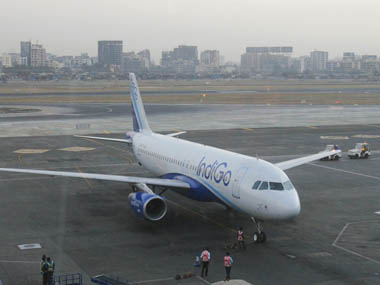By Farah Bookwala Vhora, CNBC-TV18
A week after India’s leading carrier by market share, IndiGo airlines, filed a draft prospectus to launch its Rs 2,500 crore initial public offering (IPO), a closer reading of its draft prospectus is raising a few eyebrows.
The draft red herring prospectus (DRHP) states that IndiGo’s term sheet with aircraft manufacturer, Airbus, signed in October 2014, for the purchase of 250 A320 neo aircraft has expired.
“On October 12, 2014, we signed a term sheet with Airbus in order to enter into a purchase agreement to acquire 250 A320neo aircraft. Although the term sheet has expired we remain in active discussions concerning the potential acquisition of a significant number of aircraft from the A320neo family. There is no assurance that we will be able to negotiate the additional aircraft purchase from Airbus or that any such purchase would use a structure or contain terms comparable to our 2005 and 2011 orders from Airbus,” says the DRHP.
This has aviation experts asking why IndiGo allowed the memorandum of understanding (MoU) to expire without purchasing the 250 aircraft it intended to buy while signing the document.
It also raises concerns about IndiGo’s ability to secure new aircraft at the same commercial and delivery terms as in the earlier MoU.
“The fact that this (MoU) has expired firstly raises questions as to why did IndiGo let it expire? Is it an issue of money or was there some other reason? And once an MoU expires, then it releases Airbus, the seller, from those terms (of the MoU),” said Devesh Agarwal, editor and analyst of bangaloreaviation.com , an aviation blog.
The performance of group entities is another point of concern.
The DRHP shows that 39 group entities have incurred losses in preceding financial years, some consistently between fiscals 2012 and 2014. Have the losses of these group entities had any impact on IndiGo’s profitability, asks another expert who did not wish to be identified.
While the DRHP states that no part of the net proceeds are payable to group entities, this has the expert mentioned above asking if IndiGo will financially support these entities in the future.
But what makes both the experts wary is IndiGo’s dividend policy. According to the DRHP, between FY11 and FY16, the airline has paid dividends and interim dividends amounting to Rs 3,500 crore to its promoters. In FY15 and FY16 alone, the company paid interim dividends totalling Rs 2,083 crore rupees to promoters. This is close to the amount IndiGo is looking to raise via its IPO.
If IndiGo is generating enough cash to pay dividends worth 3,500 crore rupees, how does it justify its decision to raise funds in the capital market, ask the experts.
More importantly, why was this money used to pay hefty dividends to promoters instead of paring down the company’s debt which stands at Rs 4002.8 crore rupees?
“It is a point of concern as to why was this money is not being put to better use in terms of investment in the airline company itself,” Agarwal of bangaloreaviation said.
The company’s profit and loss statement also throws up another question. ‘Other expenses’ have risen from Rs 652 crore in FY10 to Rs 2,447 crore rupees in FY14. This is a four-fold increase.
The DRHP does not provide a break up of these other expenses.
Experts say is important to understand the composition of these ‘other expenses’ and why they have risen so dramatically.
IndiGo Airlines has not responded to a detailed questionnaire sent by CNBC-TV18.


)




)
)
)
)
)
)
)
)